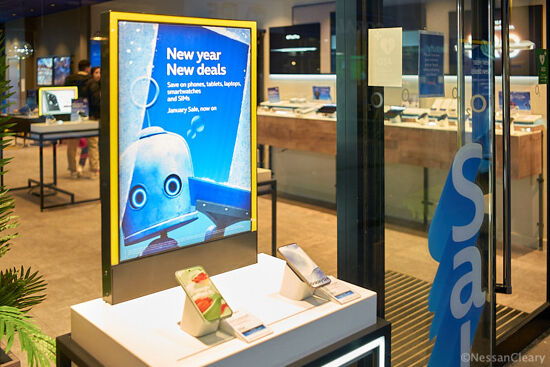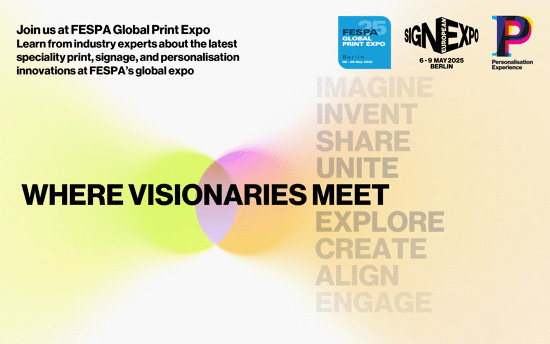Lenticular printing explained: Part 2 - Creation and production
Setting up images for lenticular print takes knowledge, experience and sometimes (but not always) expensive software.
In part one of this feature, we introduced lenticular printing, its effects, applications and opportunities. In part two, we explore the software needed to create this dynamic images.
It may be easiest to go to an outside specialist who’s set up to offer trade services for part or all of the process. However, the skills can be learned and taught and the basic software may already be to hand.
Simple image-changing flips (say a winking eye) can be set up relatively easily in a multi-layer imaging program, most usually Adobe Photoshop. This will also work for more complex animations, though a more specialist program such as Adobe Flash might be useful for the initial stages.
Morphing (the changing of one shape into another) is more complex: there are dedicated programs, or the effects are included in some animation programs such as Cinema 3D or Adobe After Effects. Frames from movie clips can be extracted relatively easily.
For true stereoscopic 3D you need a camera system that takes pairs of images from different viewpoints. There has been a handful of 3D digital cameras on the market in recent years, though all seem to have been withdrawn now. The most prominent was the amateur-oriented Fujifilm Real 3D W1 and second-generation W3 cameras (such as that pictured below, currently available second-hand for around USD/EUR500), which had two lenses and sensors plus a built-in lenticular preview/playback screen as well as an optional larger format standalone playback screen.
In their absence it’s a relatively simple task to put two cameras side by side on a rail and to fire them simultaneously. If you’re shooting still life then you can use one camera and move it between shots. A smoother, more ‘3D’ effect can be achieved with more than two shots (or by artificially morphing in-between shots from the two real originals).
Quite a lot of the images seen in 3D lenticular prints are not true stereoscopic images at all: they are conventional 2D images whose elements have been separated into layers, with software that fills in the edges of the resulting holes and simulates depth between the layers (and can be achieved easily with the latest version of Photoshop, with its 'Content Aware Fill' tool). This effect works surprisingly well, even though each layer is actually flat.
The little stereo viewer postcards sold in museums, galleries and souvenir shops worldwide use this technique to get 3D out of practically anything, even Renaissance paintings. These will be printed by lithography though.
Software
The production stage of lenticular imaging converts the images into interlaced strips with the appropriate measurements for the lens material, printing process, print size, resolution and halftone setting.
There is a fair choice of software available to do this, at a range of prices, with some being free for testing or amateur use. Most is for Windows PCs, but there is some for MacOSX.
The software is often available in several versions, priced according to the process, maximum size and lens pitch. Low lens pitches and small sizes tend to be low cost, but large formats and high lens pitches are much more expensive.
It’s possible to set up the interlaced stripes yourself for “free” using standard software such as Photoshop by writing scripts, but it’s not easy and it demands a decent understanding of the process in order to calculate the resolution and stripe widths.
DP Lenticular has created a good reference page with links to the main developers of lenticular creative and production software.
We’ve also produced our own guide to the most prominent current software:
A selection of lenticular software packages
3D Mix, a series of lenticular-related Windows software, has been developed in Russia by Evgeniya Vazenmiller. There are various programs and calculators, some costing as little as €20. PhotoProjector Plus is an interlacer for large format/high pixel count images and costs €212. ViewsAligner takes stereo pairs and lets you manually set up matching points for 3D lenticular imaging, with built-in interlacing. It costs €177.
3DZ is one of the first lenticular software suites and is still being developed in 2015. Its 3D Lenticular Suite 2015 includes applications to do pretty well everything needed at the creative, production and output stages. Its current interlacer is called V7.
HumanEyes is well known in the market due to its initial high profile publicity as much as its ease of use. Its Designer 3D software costs about €270 and can set up multi-layer 2D-3D simulations, true stereo 3D, flips, animations and 3D previewing. The Producer 3D software for the output stage is comparatively expensive for large format and high resolution licenses (€8,500 and above). Rental models are available.
Imagiam, in Barcelona, has been selling its Lenticular Effects modular suite since 2000. This runs on Mac OSX or Windows and offers the creation, interlacing and printing of lenticular images with different effects: flip, zoom, movement, animation, 3D, etc. Developer David Garcia says it is used in demo suites by Heidelberg, KBA and Canon/Océ Denmark.
There are three levels: Standard for €838 (for lenses up to 80 lpi); Pro for €1,438 (also up to 80 lpi but with additional offset printing and imposition features; and Ultra at €1,938 (full feature set with no lens pitch limitation).
The Standard version is fine for large format inkjet work, but the Pro version adds a few useful features such as PDF export and depth checking.
Imagiam's Lenticular Effects can import layered Photoshop files and output complex multi-framed animations to mainstream digital printers.
Lenticulator Interlacer is a Photoshop add-on for Mac OS X, created by French lenticular photographer Henri Clement and his brother Thomas. It’s a four-stage process taking you through settings menus, though two stages are optional. The software costs €400 for professional use, but there is a free demo version.
Power Illusion, from the US company Photo Illusion, is the €1,350 commercial version of its image setup and production suite. It runs on Macintosh or Windows (though the references to XP suggest it’s not updated very often). The Home Illusion kit is a €153 starter kit for A4 images, including software, ten sheets of A4 40lpi lenses and a cold laminator. At the time of writing a 50% off offer is on the company’s website.
Triaxes in Tomsk, Russia, offers Windows-based software in a range of prices. Its large format print preparation software for inkjets is called Legend. This can prepare images to print directly onto the lens material, rather than by lamination. Prices depend on output size and resolution, but the versions most relevant to large format are Photo 90 for up to 90 cm on the longest side (€400), Print 180 (up to 1.8 m for €550) and Pro, for up to 3.6 m (€700). There are separate programs for special functions such as converting stereo pairs to multi-view 3D.
Topics
Interested in joining our community?
Enquire today about joining your local FESPA Association or FESPA Direct
Recent news

Vote now for the FESPA Awards’ People’s Choice Award!
The voting for the prestigious People's Choice FESPA Award is now open until 7th February where those in the industry have the opportunity to vote for their favourite entries, celebrating the exceptional talent in the industry.
.png?width=550)
FESPA MIddle East 2025 - Day 3 Highlights
The third day of FESPA Middle East, 22 January 2025, featured hundreds of professionals visiting the show to see the latest solutions and innovations in speciality print and signage.

The rise of digital screens
Nessan Cleary discusses the increasing use of digital screen in retail shops which have both pros and cons. They can be cost-effective with a variety of different technologies and resolutions that can be used and reduces the amount of short term printing required. However, they do require high amounts of energy to run. Nessan goes into further detail of the pros and cons in this article.

FESPA 2025: Where Visionaries Meet
Michael Ryan, Head of Global Business Development and Global Print Expo shares how the upcoming FESPA Global Print Expo, European Sign Expo and Personalisation Experience shows will be the meeting point where visionaries meet. Michael shares the upcoming features that will be present at these shows.